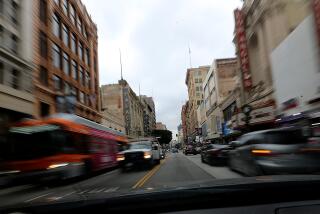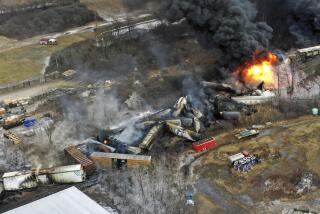Funicular Checked by PUC Once Since ’96
- Share via
No Public Utilities Commission inspection of Angels Flight was performed for four years after the block-long downtown railway resumed service in 1996, PUC records show.
When a formal inspection was conducted last year, it consisted mainly of a review of the railway company’s records rather than a direct inspection of the operating parts of the cable system, the PUC’s inspector assigned to the railway said Wednesday.
The inspector, PUC transportation engineer Joey E. Bigornia, acknowledged in an interview that he did not have the technical expertise to inspect the funicular system on his own and reach conclusions as to its safe operation.
Last July, Bigornia conducted the PUC’s first safety oversight inspection of Angels Flight. He found that the private operators did not maintain inspection report forms detailing the results of their own monthly, six-month and yearly inspections. He recommended that they develop such forms, and he renewed his request in a follow-up letter in January.
Bigornia accepted a date of Feb. 1 for the railway operators to implement the recommendations, but John H. Welborne, manager of the operating company, has said he planned to seek an extension.
Feb. 1 turned out to be the day that one of the system’s cars hurtled down the track and struck the other, killing an 83-year-old New Jersey resident and injuring seven other passengers.
The accident is under investigation by the National Transportation Safety Board.
Bigornia’s comments were confirmed by documents made available to The Times this week by the PUC, the agency whose railway division is charged with safety oversight for trains, subways and Angels Flight.
Bigornia, after his July 6 inspection, wrote a letter dated Sept. 21 to railway operator Welborne, recommending that inspection forms be developed that “clearly show each item inspected, the results of the inspections in terms of defects found, repairs made, and the identity of the person who performed the inspection.”
Welborne said Wednesday that the operators conducted regular inspections from the time the historic railway reopened in early 1996 to the day of the accident. But they were not written up in detail, he said.
“I could have drawn up the form in 20 minutes,” Welborne said. He added that he had been granted one extension from Bigornia in November, to Feb. 1, and was going to ask for a second extension “for a weekend” on that fateful day.
In San Francisco, the director of the PUC’s Rail Safety and Carrier Division, Kenneth Koss, said the PUC’s inspection regimen is based on guidelines of the Federal Transit Administration of the U.S. Department of Transportation.
“What those guidelines say . . . is that the property itself does in fact do the heavy lifting work, the precise inspections,” he said. “They call for only a triennial audit.”
Koss, however, agreed Wednesday that no formal PUC inspections had been done for four years until last July, although he and Bigornia both noted that on a couple of occasions in 1998 and 1999, Bigornia had gone to Angels Flight for informal “observations” lasting 30 minutes to an hour, which were not written up.
Legally, Koss said, Angels Flight is not under the federal guidelines because it does not receive federal money, but the PUC has decided to adopt those guidelines.
For conventional railroads, Koss said, “the Federal Railroad Administration does require annual or semi-annual inspects, and there we are supposed to do the heavy lifting,” meaning provide a detailed look, rather than just review records.
The only written records of the PUC looking at Angels Flight after it opened until mid-2000 was in March 1997, when two PUC employees observed a private company’s inspection of the railway’s cable ropes.
Five days after that observation, Bigornia wrote to Welborne:
“It is anticipated that we will conduct a thorough inspection of the Angels Flight Operation and Maintenance Procedures within the next several months.”
Asked Wednesday whether he had performed that promised inspection, Bigornia answered, “No, I did not.” He did not elaborate.
Asked if his July visit had involved inspecting the cables, brakes, or any gears or motors that may have failed, Bigornia replied, “No, sir.”
Bigornia said that when he did conduct his limited inspection, “I was trying to check their system against any requirement for inspection they had, and I wasn’t finding any details.
“They told me they had performed the inspections,” he said.
In his September letter, he wrote, “It was discovered that the Angels Flight Railway does not have a specific inspection report form for documenting the results of the required monthly inspections.
“Normally, a simple entry is made in a daily log book stating that the monthly inspections were performed. However, no such entries were found for the months of June, July and September 1999.”
However, Bigornia was assured by the company’s inspector that the inspections had been done.
Asked if the paper check he recommended would be more satisfactory than verbal assurances, Bigornia responded, “Yes, yeah.”
After all, he emphasized, he was there to review inspection records and not to personally inspect the system.
The day of the Feb. 1 accident, Koss had refused to release the PUC’s inspection records but said they would show that no mechanical flaws had turned up. Days later, the PUC made public the report on the July 2000 inspection.
When the PUC’s full Angels Flight inspection records were released this week after The Times filed a Freedom of Information Act request, they showed no other formal inspections had been made.
The accident took the life of tourist Leon Praport, a Holocaust survivor. His wife, Lola, who was seriously injured, is set to be released from County-USC Medical Center tonight after undergoing numerous surgeries for skin grafts.
More to Read
Sign up for The Wild
We’ll help you find the best places to hike, bike and run, as well as the perfect silent spots for meditation and yoga.
You may occasionally receive promotional content from the Los Angeles Times.






